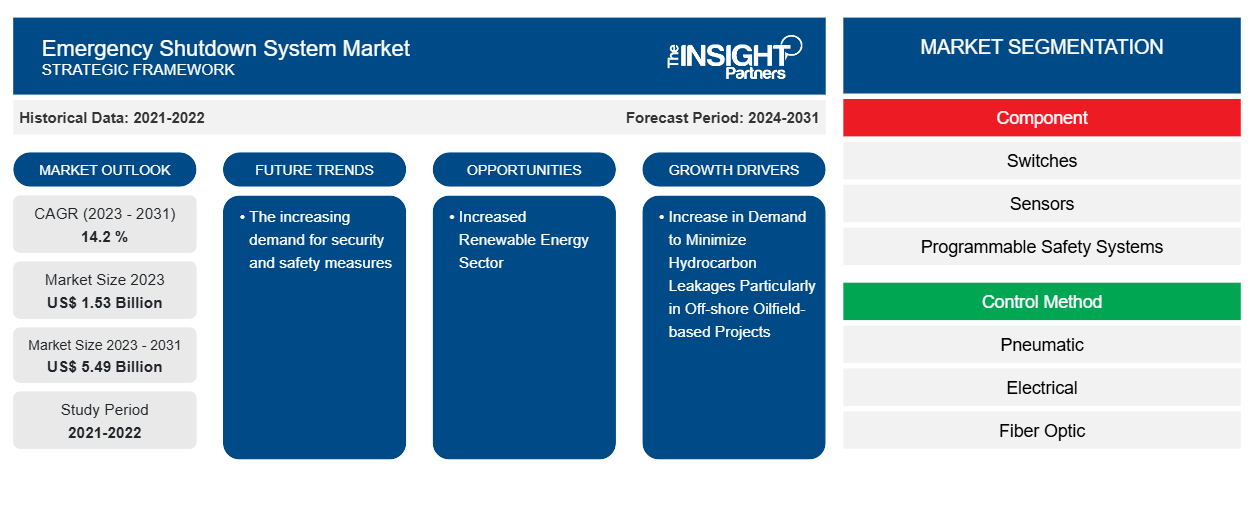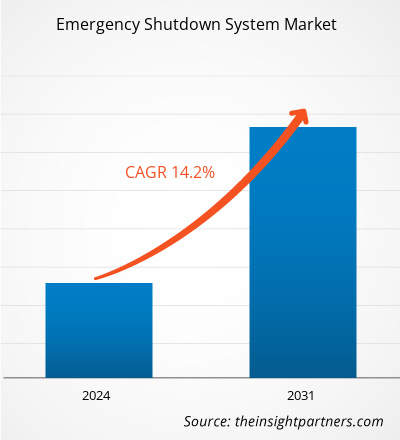The emergency shutdown system market size is projected to reach US$ 5.49 billion by 2031 from US$ 1.53 billion in 2023. The market is expected to register a CAGR of 14.2 % in 2023–2031. The increasing demand for safety and security measures is likely to remain a key emergency shutdown system market trend.
Emergency Shutdown System Market Analysis
The emergency shutdown system is heavily influenced by the strong presence of large enterprises across various end-user industry verticals owing to their significantly large industrial process equipped with various technological solutions.
Emergency Shutdown System Market Overview
A system known as an emergency shutdown system, or ESD, is employed in dangerous environments to avert scenarios that could have disastrous consequences for the economy, the environment, or operations. By preventing things like leaks, hydrocarbon escape, fire outbreaks, and explosions, they are made to reduce the effects of emergency circumstances, such as harm to people or destruction of equipment. Boilers, gas and steam turbine power plants, oil and gas processing facilities, and oilfields (oil well heads) all include emergency shutdown mechanisms.
Customize This Report To Suit Your Requirement
You will get customization on any report - free of charge - including parts of this report, or country-level analysis, Excel Data pack, as well as avail great offers and discounts for start-ups & universities
Emergency Shutdown System Market: Strategic Insights

-
Get Top Key Market Trends of this report.This FREE sample will include data analysis, ranging from market trends to estimates and forecasts.
Emergency Shutdown System Market Drivers and Opportunities
Increase in Demand to Minimize Hydrocarbon Leakages, Particularly in Offshore Oilfield-based Projects
The purpose of an emergency shutdown system (ESD) is to reduce the effects of situations that are generally linked to uncontrolled floods, the escape of hydrocarbons, or fire breakouts in hazardous industries or locations where hydrocarbons are present. Historically, risk analysis has shown that the emergency shutdown program needs a high safety integrity grade (SIL 2 or 3). Device logic for incoming signal processing, field-mounted sensors, valves, trip relays, warnings, and HMI modules make up the majority of the system. The cause and effect diagrams created for the installation are followed by the device when processing input signals and triggering outputs. Growing upstream operations and rising oil and gas prices are expected to drive up demand for emergency shutdown systems (ESDs), particularly from offshore facilities. Midstream, upstream, and downstream oil refinery activities are the primary sources of demand for ESDs. The offshore oil and gas business in the US and Europe is subject to safety and environmental restrictions that are enforced by laws and regulations such as the Bureau of Safety and Environmental Enforcement (BSEE). Close monitoring is done of temperature and pressure to reduce the possibility of mishaps or accidents.
Increased Renewable Energy Sector
The renewable energy sector is growing significantly worldwide. According to the United Nations Report, renewable energy sources are available in every country, and their potential is yet to be fully harnessed. The International Renewable Energy Agency (IRENA) approximates that 90 % of the world’s electricity can and should come from renewable energy by 2050. Renewable energy sources provide a means of escaping reliance on imports, diversifying national economies, shielding them from the volatile price fluctuations of fossil fuels, and promoting inclusive economic growth, job creation, and poverty reduction. The emergency shutdown systems are used in this sector to provide safe operations. If hazardous conditions occur, instant action should be taken. An emergency shutdown system is used to shut down the facility to a safe state and protect the environment and the assets.
Emergency Shutdown System Market Report Segmentation Analysis
Key segments that contributed to the derivation of the emergency shutdown system market analysis are component, control method, and end-user industry (oil & gas, refining, power generation, chemical, and others)
- Based on the components, the emergency shutdown system market is segmented into switches, sensors, programmable safety systems, safety valves, actuators, and others. The sensors segment held a larger market share in 2023.
- By control method, the market is segmented into pneumatic, electrical, fiber optic, and hydraulic.
- By end-user industry, the market is segmented into oil & gas, power generation, refining, chemical, and others.
Emergency Shutdown System Market Share Analysis by Geography
The geographic scope of the emergency shutdown system market report is mainly divided into five regions: North America, Asia Pacific, Europe, Middle East & Africa, and South America/South & Central America. In terms of revenue, APAC accounted for the largest emergency shutdown system market share. The APAC region, owing to the strong presence of unorganized small and medium end-users along with limited government regulation, has attributed the region’s low market share despite the strong presence of an end-user base in the region.
Emergency Shutdown System Market News and Recent Developments
The emergency shutdown system market is evaluated by gathering qualitative and quantitative data post primary and secondary research, which includes important corporate publications, association data, and databases. The following is a list of developments in the market for speech and language disorders and strategies:
- In March 2023, the US Chemical Safety and Hazard Investigation Board (CSB) issued a new Safety Alert titled “Hazards Posed by Discharges from Emergency Pressure-Relief Systems.” The CSB’s alert highlights hazards identified with emergency pressure-relief systems from four CSB investigations. The alert advises facilities that while a discharge from emergency pressure-relief systems can help protect equipment from unexpected and undesired high-pressure events, it can also seriously harm or fatally injured workers and cause extensive damage to a facility if the discharge is not made to a safe location. (Source: U.S. Chemical Safety Board, Press Release)
Emergency Shutdown System Market Report Coverage and Deliverables
The “Emergency Shutdown System Market Size and Forecast (2023–2031)” report provides a detailed analysis of the market covering below areas:
- Market size and forecast at global, regional, and country levels for all the key market segments covered under the scope
- Market dynamics such as drivers, restraints, and key opportunities
- Key future trends
- Detailed PEST/Porter’s Five Forces and SWOT analysis
- Global and regional market analysis covering key market trends, major players, regulations, and recent market developments
- Industry landscape and competition analysis covering market concentration, heat map analysis, prominent players, and recent developments
- Detailed company profiles
Emergency Shutdown System Market Regional Insights
The regional trends and factors influencing the Emergency Shutdown System Market throughout the forecast period have been thoroughly explained by the analysts at The Insight Partners. This section also discusses Emergency Shutdown System Market segments and geography across North America, Europe, Asia Pacific, Middle East and Africa, and South and Central America.
Emergency Shutdown System Market Report Scope
| Report Attribute | Details |
|---|---|
| Market size in 2023 | US$ 1.53 Billion |
| Market Size by 2031 | US$ 5.49 Billion |
| Global CAGR (2023 - 2031) | 14.2 % |
| Historical Data | 2021-2022 |
| Forecast period | 2024-2031 |
| Segments Covered |
By Component
|
| Regions and Countries Covered |
North America
|
| Market leaders and key company profiles |
|
Emergency Shutdown System Market Players Density: Understanding Its Impact on Business Dynamics
The Emergency Shutdown System Market is growing rapidly, driven by increasing end-user demand due to factors such as evolving consumer preferences, technological advancements, and greater awareness of the product's benefits. As demand rises, businesses are expanding their offerings, innovating to meet consumer needs, and capitalizing on emerging trends, which further fuels market growth.

- Get the Emergency Shutdown System Market top key players overview
Frequently Asked Questions
What will be the market size of the global emergency shutdown system market by 2031?
Which are the key players holding the major market share of the global emergency shutdown system market?
What are the future trends of the global emergency shutdown system market?
What are the driving factors impacting the global emergency shutdown system market?
What is the estimated market size for the global emergency shutdown system market in 2023?
- Historical Analysis (2 Years), Base Year, Forecast (7 Years) with CAGR
- PEST and SWOT Analysis
- Market Size Value / Volume - Global, Regional, Country
- Industry and Competitive Landscape
- Excel Dataset
Recent Reports
Related Reports
Testimonials
Reason to Buy
- Informed Decision-Making
- Understanding Market Dynamics
- Competitive Analysis
- Identifying Emerging Markets
- Customer Insights
- Market Forecasts
- Risk Mitigation
- Boosting Operational Efficiency
- Strategic Planning
- Investment Justification
- Tracking Industry Innovations
- Aligning with Regulatory Trends





















 Get Free Sample For
Get Free Sample For